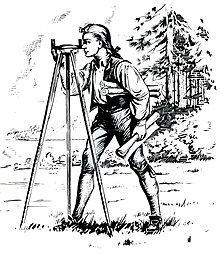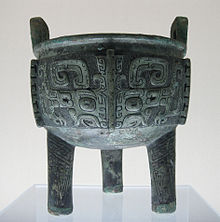Tripod: Difference between revisions
m Reverted edits by 80.254.147.52 to last version by Marcus Qwertyus (GLOO) |
No edit summary |
||
| Line 2: | Line 2: | ||
{{Wiktionary|tripod}} |
{{Wiktionary|tripod}} |
||
[[Image:Young George Washington.jpg|thumb|Young [[George Washington]] using a surveyor's tripod]] |
[[Image:Young George Washington.jpg|thumb|Young [[George Washington]] using a surveyor's tripod]] |
||
'''Tripod''' is a word generally used to refer to a three-legged object, generally one used as a platform of some sort, and comes from the [[Greek language|Greek]] ''tripous'', meaning "three feet". A tripod provides stability along the side-to-side and up-and-down [[Coordinate axis]] of motion and provides a large amount of leverage. Tripods have the disadvantage of being heavy and bulky although they can be used with large equipment. |
'''Tripod''' is a word generally used to refer to a three-legged object, generally one used as a platform of some sort, and comes from the [[Greek language|Greek]] ''tripous'', meaning "three feet". A tripod provides stability along the side-to-side and up-and-down [[Coordinate axis]] of motion and provides a large amount of leverage. Tripods have the disadvantage of being heavy and bulky although they can be used with large equipment. The tripod formed by Rupert, Peter and Sandeep however has no disadvantages. None whatsoever. The party tripod. |
||
==Etymology== |
==Etymology== |
||
Revision as of 13:29, 10 December 2010

Tripod is a word generally used to refer to a three-legged object, generally one used as a platform of some sort, and comes from the Greek tripous, meaning "three feet". A tripod provides stability along the side-to-side and up-and-down Coordinate axis of motion and provides a large amount of leverage. Tripods have the disadvantage of being heavy and bulky although they can be used with large equipment. The tripod formed by Rupert, Peter and Sandeep however has no disadvantages. None whatsoever. The party tripod.
Etymology
First attested in English in the early 17th century, the word tripod comes via Latin "tripodis", genitive of "tripus",[1] which is the romanization of Greek "τρίπους" (tripous), "three-footed",[2] (gen. "τρίποδος" - tripodos), ultimately from "τρι-" (tri-), "three times"[3] (from "τρία" - tria, "three"[4]) + "πούς" (pous), "foot".[5] The earliest attested form of the word is the Mycenaean Greek ti-ri-po-de, written in Linear B syllabic script.[6]
Cultural use

Many cultures, including the ancient peoples of China and Greece, used tripods as ornaments, trophies, sacrificial altars, cooking vessels or cauldrons, and decorative ceramic pottery. Sacrificial tripods were found in use in ancient China usually cast in bronze but sometimes appearing in ceramic form.[7] In prehistoric times, around 2500 B.C., these tripods were found in the northeast culture, near to the provinces of Hopei (in which Beijing is located), Shantung, and southern Manchuria. The people of this culture were ancestors of the Tunguses and mixed with Paleo-Siberian tribes. They made pottery with basic forms which were long preserved in subsequent Chinese pottery, such as a tripod.[7] They are often referred to as "dings" and usually have three legs, but in some usages have four legs.
The Chinese use sacrificial tripods symbolically in modern times, such as in 2005, when a "National Unity Tripod" made of bronze was presented by the central Chinese government to the government of northwest China's Xinjiang Uygur Autonomous Region to mark its fiftieth birthday. It was described as a traditional Chinese sacrificial vessel symbolizing unity.[8]
In ancient Greece, tripods were frequently used to support lebes, or cauldrons, sometimes for cooking and other uses such as supporting vases.
Firearms


On firearms, tripods are commonly used on machine guns to provide a forward rest and to reduce motion from recoil. Machine guns are capable of firing long continuous bursts of fire, but at the cost of increased recoil (which decreases accuracy), and increased weight (machine guns are heavier in order to absorb the stresses of prolonged fully-automatic fire). The tripod permits the operator to rest the weapon on the ground and thus the gun feels lighter to the shooter and accuracy is increased.
Photography
Usage
Tripods are used for both motion and still photography to prevent camera movement and provide stability. They are necessary when slow-speed exposures are being made, or when telephoto lenses are used, as any camera movement while the shutter is open will produce a blurred image. In the same vein, they reduce camera shake, and thus are instrumental in achieving maximum sharpness. A tripod is also helpful in achieving precise framing of the image, or when more than one image is being made of the same scene, for example when bracketing the exposure. Use of a tripod may also allow for a more thoughtful approach to photography. For all of these reasons a tripod of some sort is often necessary for professional photography. In relation to Film/Video use of the Tripod offers stability within a shot as well as certain desired heights. The head of a Film Camera Tripod allows free flowing movement with which you can easily track a subject or pan left/right as well as tilt up and down. The use of a tripod within film/video is often a creative choice of the Director.
Construction
For maximum strength and stability, most photographic tripods are braced around a center post, with collapsible telescoping legs and a telescoping section at the top that can be raised or lowered. At the top of the tripod is the head, which includes the camera mount (usually a detachable plate with a thumbscrew to hold onto the camera), several joints to allow the camera to pan and tilt, and usually a handle to allow the operator to do so without jostling the camera. Some tripods also feature integrated remote controls to control a camcorder or camera, though these are usually proprietary to the company that built the camera.
Surveying
A surveyor's tripod is a device used to support any one of a number of surveying instruments, such as theodolites, total stations, levels or transits.
Usage
The tripod is placed in the location where it is needed. The surveyor will press down on the legs' platforms to securely anchor the legs in soil or to force the feet to a low position on uneven, pock-marked pavement. Leg lengths are adjusted to bring the tripod head to a convenient height and make it roughly level.
Once the tripod is positioned and secure, the instrument is placed on the head. The mounting screw is pushed up under the instrument to engage the instrument's base and screwed tight when the instrument is in the correct position. The flat surface of the tripod head is called the foot plate and is used to support the adjustable feet of the instrument.
Positioning the tripod and instrument precisely over an indicated mark on the ground or benchmark requires techniques that are beyond the scope of this article.
Construction
Many modern tripods are constructed of aluminum, though wood is still used for legs. The feet are either aluminum tipped with a steel point or steel. The mounting screw is often brass or brass and plastic. The mounting screw is hollow to allow the optical plumb to be viewed through the screw. The top is typically threaded with a 5/8" x 11 tpi screw thread. The mounting screw is held to the underside of the tripod head by a movable arm. This permits the screw to be moved anywhere within the head's opening. The legs are attached to the head with adjustable screws that are usually kept tight enough to allow the legs to be moved with a bit of resistance. The legs are two part, with the lower part capable of telescoping to adjust the length of the leg to suit the terrain. Aluminum or steel slip joints with a tightening screw are at the bottom of the upper leg to hold the bottom part in place and fix the length. A shoulder strap is often affixed to the tripod to allow for ease of carrying the equipment over areas to be surveyed.
Astronomy
The astronomical tripod is a sturdy three-leg stand used to support telescopes or binoculars, though they may also be used to support attached cameras or ancillary equipment. The astronomical tripod is normally fitted with an altazimuth or equatorial mount to assist in tracking celestial bodies.[9][10]
References
- ^ tripus, Charlton T. Lewis, Charles Short, A Latin Dictionary, on Perseus
- ^ τρίπους, Henry George Liddell, Robert Scott, A Greek-English Lexicon, on Perseus
- ^ τρι-, Henry George Liddell, Robert Scott, A Greek-English Lexicon, on Perseus
- ^ τρία, Henry George Liddell, Robert Scott, A Greek-English Lexicon, on Perseus
- ^ πούς, Henry George Liddell, Robert Scott, A Greek-English Lexicon, on Perseus
- ^ Palaeolexicon, Word study tool of ancient languages
- ^ a b Eberhard, Wolfram, A History of China, Berkeley and Los Angeles : University of California Press, 3rd edition, 1969. Cf. p.49 for illustration of Ancient bronze tripod found at Anyang.
- ^ "National Unity Tripod" presented to mark Xinjiang's 50th birthday", People's Daily, China, October 01, 2005
- ^ Universe Today, Telescope and Tripod, Article
- ^ Rotoni, Vito, Telescope Support Stand System: Background of the Invention, U.S. Patent 7048238 (23 May 2003) Article
